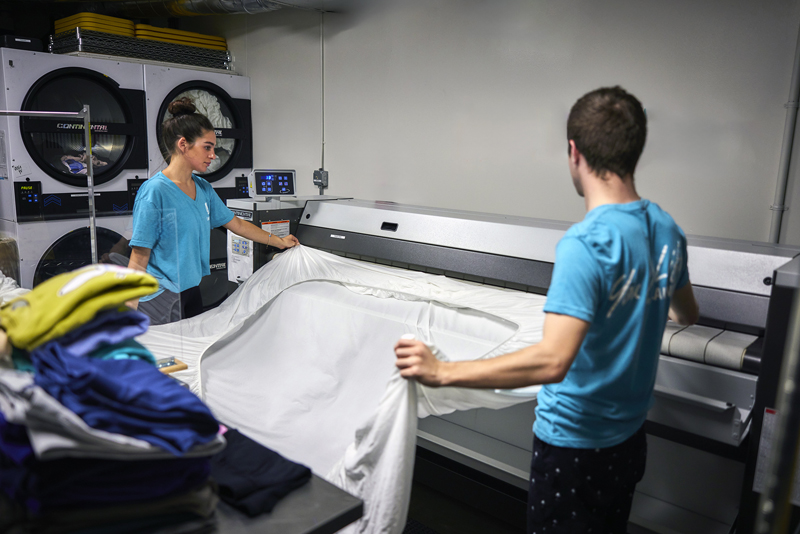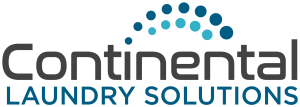How to Maximize Revenue with Full-Service, After-Hours Work
Savvy laundry owners often glean revenue from multiple services, even when it means processing full-service work after hours. Although growing the full-service side of your laundry business will take time, if the operation grows large enough, it might become necessary to make some key decisions about your business’ direction and goals.
No store owner ever wants to get in the way of self-service customers to process full-service work. However, if a laundromat hasn’t been designed to accommodate the equipment, staffing, and storage space required for a robust full-service business, the operator will need to either process that laundry after hours or move to another space. Laundry owners often discover they can be quite profitable doing more commercial turns, while maximizing revenue per square foot.
Some Real-Life Examples
I know several laundromats that process full-service work after hours – including Perfect Wash Express Laundry in Huntington Beach, Calif., and Boulder Express Laundromat, with locations in Garden Grove, Calif., and Las Vegas.
A small store, Perfect Wash organizes and stores processed orders using a conveyor system near the ceiling – above all of the equipment and out of the way of customers. After hours, company vans deliver the processed orders to area residences and businesses. In addition, Perfect Wash is often the backup plan when smaller local hotels hit a snag with a downed washer while running at full capacity. And, because it serves as an emergency backup, Perfect Wash can charge a premium for these services.
Similarly, the Boulder Express Las Vegas location works with area hotels, while the Garden Grove store serves vacation rentals and small hotels. Both have been enjoying huge growth within this segment.
Walk Before You Run
Be sure that you’re doing full-service was-dry-fold well before adding any night shifts.
If you currently own a laundromat and already process full-service work well and profitably, it might be worth considering an after-hours shift. This scenario means you still can utilize your self-service washers and dryers as long as you’ve got enough storage space for dirty and clean items. However, if you plan to focus on serving small businesses – such as spas, salons, vacation rentals, or food and beverage companies – you will require more sophisticated washer programming.
Using Vended Equipment to Operate After Hours
The good news is that some vended washers can switch from basic, self-service programming to the sophisticated programming necessary for removing tougher stains like makeup, blood, grass stains, juice, oils, and sunscreens. These involve higher water temperatures, numerous bath exchanges, and the automatic injection of commercial chemistry. Commercial-grade detergents, brighteners, and softeners are specially formulated to work with the water’s pH and alkalinity to better loosen and suspend soils. They’re much more effective than the popular over-the-counter products customers typically bring into self-service laundries. Plus, just ounces of these professional products need to be added to the washer cycle, as opposed to cups of the over-the-counter detergents. This cuts costs and waste while boosting results.
If you don’t have equipment that can switch to more sophisticated programming and automatically inject chemistry, perhaps consider removing a few self-service washers and purchasing new vended washers with this functionality or even dedicated on-premises washers.
Of course, once the WDF/commercial work is processed, your attendants can return the machines back to their self-service programming.
Making Room for Full-Service Laundry
Most laundries are short on space, so storing dirty and clean full-service items can be challenging. One way to save space is by immediately transferring the cleaned and packaged WDF/commercial laundry to your pickup-and-delivery vehicles; leave these vehicles locked, loaded, and ready for delivery the next day. Or maybe store these garments and linens in an area away from your walk-in customers – similar to what Perfect Wash does with its above-it-all conveyor system. Moreover, some laundry operators will store these full-service items in an office or a back room equipped with ample shelving.
Go Big with a Flatwork Ironer
There’s no better way to improve revenue and handle larger accounts than by adding a flatwork ironer. I know several owners who’ve done this and launched wash-dry-fold/commercial account sales as a result. An ironer will help you service hospitality and residential clients who demand ironed sheets and table linens – and, in the process, you’ll probably get their towel and blanket business, too.
A flatwork ironer – which requires about 200 square feet of space and two operators – will dry, iron, and partially fold approximately two sheets per minute, depending on the specific model. If you’re at this stage of the game and are committed to operating out of your laundromat, you’ll likely need to remove some washers and dryers, or rework a room to make space for this important piece of equipment.
Sparklean Laundry, located near Palm Springs, Calif., eliminated a second restroom, got rid of two stack dryers, and moved a wall to accommodate its ironer – which was installed in the middle of the store, surrounded by floor-to-ceiling glass. The store’s ironer not only dries, irons, and partially folds tablecloths up to 10 feet in diameter, king sheets, king duvets, pillowcases, and napkins, but it also opened the doors to new business.
As a result of this surge, Sparklean has added a third shift to help process its now 8,000 pounds of commercial and residential WDF work it receives each week.
Obtaining a Second Building… Or Adding to What You’ve Got
Not every laundromat can be easily altered to add an ironer. If this is the case, chances are good you’ll need a separate dedicated space for the ironer, as well as the processing and storing of your full-service work.
It would be ideal to lease or buy a building next to or near your laundromat, thus reducing your need to purchase new washers and dryers. However, another idea is to add on to the back of your current laundry. And, lastly, many owners opt for a completely separate processing space, dedicated strictly to residential and commercial wash-dry-fold laundry.
Whichever option eventually works best for your situation, get your laundry distributor involved early in the process to help you with site selection, design, layout, equipment mix, and automation options.
Track Orders with a POS System
If you’re committed to growth, it’s an absolute must to track and manage your full-service orders using a point-of-sale system. Your POS system should automatically email order status updates to customers, keeping them constantly in the loop. A quality system will simplify your business’ accounting, management, pickup-and-delivery service, and much more.
No doubt, if you’re committed to residential and commercial WDF growth, a little knowledge and creativity can go a long way. A great place to start is with education through your equipment distributor, as well as through CLA.












